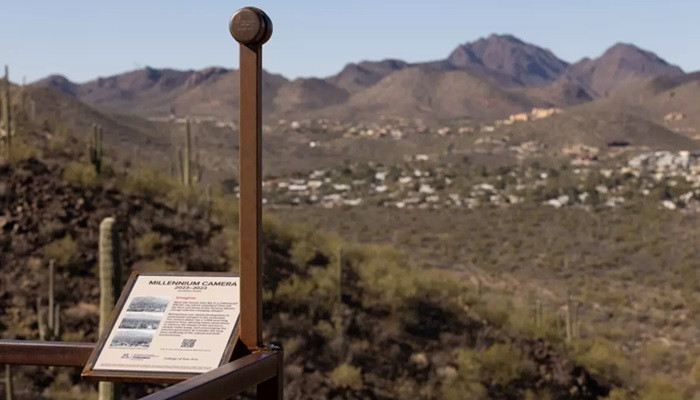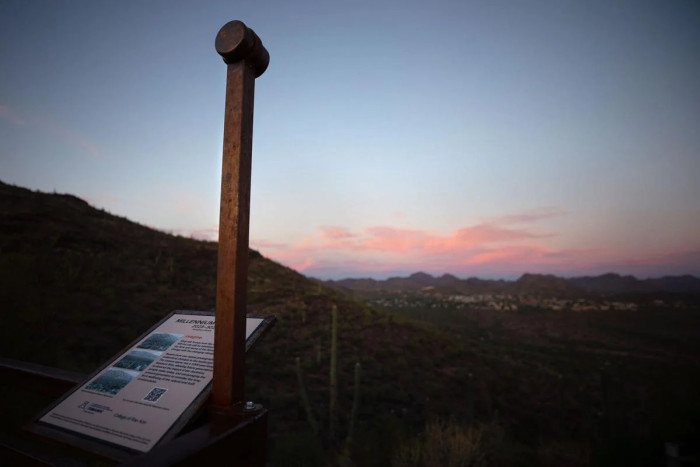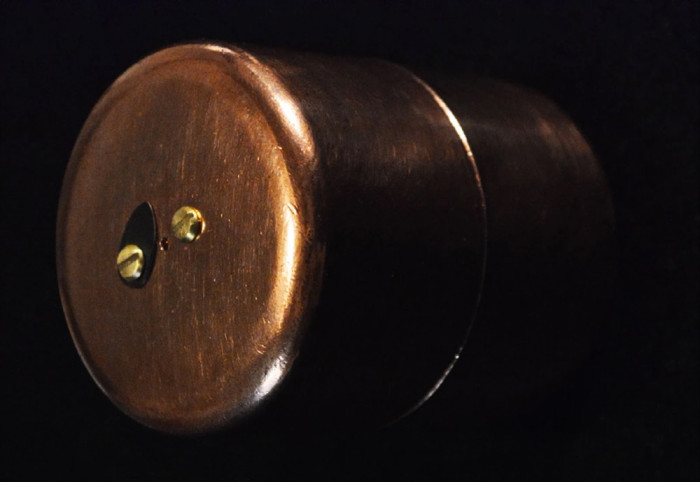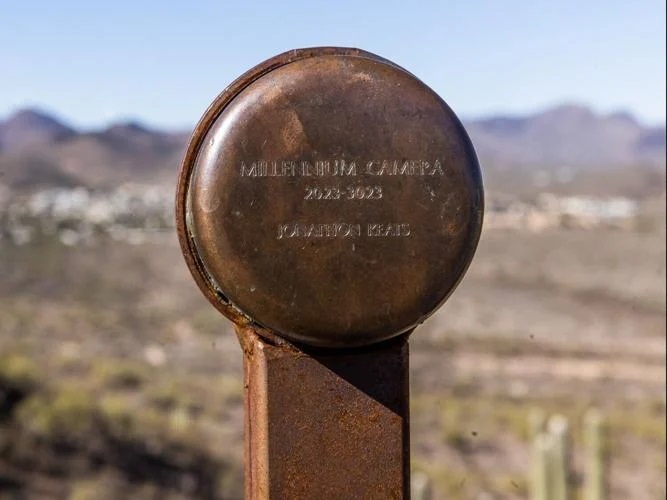Looking through the lens of time with the Millennium Camera
 29429 Saturday, 13 January, 2024, 22:48 Jonathon Keats envisioned the Millennium Camera, seen here peering across the desert landscape toward the Star Pass neighborhood West of Tumamoc Hill in Tucson, to provide not only a record of the past for future humans but also to instigate discussion about what current humans can do to influence the future.Chris Richards, University Communications Dubbed the Millennium Camera, the device was dreamed up by the experimental philosopher Jonathon Keats, a research associate at the University of Arizona College of Fine Arts. For a camera to last so long, it must be simple. Through a pin-sized hole in a thin sheet of 24-karat gold, light will slip into a small copper cylinder mounted atop a steel pole. Over 10 centuries, sunlight reflected from Tucson's landscape will slowly fade a light-sensitive surface coated in many thin layers of rose madder, an oil paint pigment. When future humans open the camera in 1,000 years, they will see an extremely long exposure image of Tucson through all its future iterations. Keats and a team of researchers from the Desert Laboratory on Tumamoc Hill installed the camera next to a bench facing west over the Star Pass neighborhood. The bench invites a pause in the hike and the camera encourages hikers to imagine what the future will hold, Keats said. "Most people have a pretty bleak outlook on what lies ahead," he said. "It's easy to imagine that people in 1,000 years could see a version of Tucson that is far worse than what we see today, but the fact that we can imagine it is not a bad thing. It's actually a good thing, because if we can imagine that, then we can also imagine what else might happen, and therefore it might motivate us to take action to shape our future." Making a camera – and a city – that will last What's more, there is no conventional photographic process that is insensitive enough to be able to take a photograph over a millennium, Keats said, which is what led him to the idea of sun-faded pigment. That rose madder will fade at the correct rate is an educated guess on Keats' part. "One thousand years is a long time and there are so many reasons why this might not work," Keats said. "The camera might not even be around in a millennium. There are forces of nature and decisions people make, whether administrative or criminal, that could result in the camera not lasting." If the camera does last, however, Keats outlines what we can assume the final image will look like: The landscape's most steadfast features will appear sharpest (although the land is not completely stable, so there will be some inevitable blur to the image). Conversely, the most dynamic parts will be softest. Sudden changes will result in what will look like multiple images overlapped. "Let's take a really dramatic case where all the housing is removed 500 years in the future," Keats said. "What will happen then is the mountains will be clear and sharp and opaque, and the housing will be ghostly. All change will be superimposed on one image that can be reconstructed layer by layer in terms of interpretation of the final image." But as much as Keats hopes to provide the future with a record of the past, he also wants to encourage people of today to plan for the future. Specifically, he thinks we should think through where populations might continue to sprawl on the landscape and reflect on that growth in relationship to the natural environment, something he said we need to be doing urgently. "By no means is the camera making a statement about development – about how we should build the city or not going forward," Keats said. "It is set there to invite us to ask questions and to enter into conversation and invite the perspective of future generations in the sense that they're in our minds." Keats is adamant that the camera is not opened before 1,000 years. "If we open in the interim, then it diminishes the imagining that we need to be doing," he said. A global perspective "Tumamoc Hill has a very deep relationship with the people of Tucson and the hill has a history to it that has this great vantage metaphorically and literally for looking across generations," Keats said. "The petroglyphs on Tumamoc Hill, for example, are a record of people looking very carefully at their environment and leaving a trace of what they've seen. That is really a form of communication across generations. In the same spirit, the Millennium Camera provides a way to observe and interact." Keats wants to install at least one more camera on Tumamoc Hill looking out in a different direction, perhaps eastward overlooking downtown Tucson. The two views will mirror each other, and reveal the dynamics of human interaction with the environment. Contingent on funding, he has also identified the Santa Rita Experimental Range as another Millennium Camera site. Experimental Range director Brett Blum and Keats identified a location "where the future is fascinatingly and deeply uncertain – an interface between the natural and human environments," Keats said. As on Tumamoc Hill, it is also a place where the public can engage with the camera and think about the future. He is also looking to install the cameras around the globe. In China, he is planning to put one in Chongqing, as well as in Griffith Park in Los Angeles. In May, he will install one in the Austrian Alps. "This project depends on doing this in many places all over the world," Keats said. "I hope this leads to a planetary process of reimagining planet Earth for future generations."    |

Staff strike forces Louvre to close doors to visitors
500Yesterday, 23:56
‘Pluribus’ is the most watched show in Apple TV history!
91614.12.2025, 22:36
Johnny Depp Sets First English-Language Adaptation of Mikhail Bulgakov’s Classic ‘The Master and Margarita’
194711.12.2025, 00:46
Golden Globes 2026: The full list of nominees
186509.12.2025, 00:32
Brazil police ID suspect in Matisse theft
186808.12.2025, 23:48
Warner Bros fight heats up with $108 billion hostile bid from Paramount
190808.12.2025, 22:59
Leonardo DiCaprio Is TIME’s 2025 Entertainer of the Year
139608.12.2025, 22:18
Water leak at Paris Louvre Museum damages books at Egyptian antiquities department
116808.12.2025, 12:12
